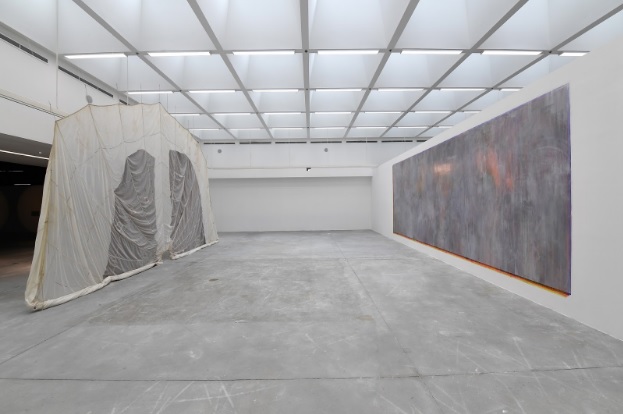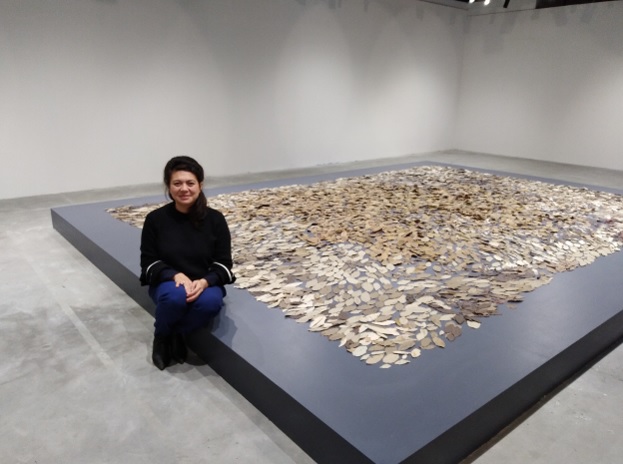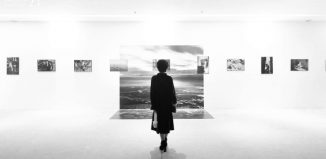A walk through “Xe Đạp Ơi” Exhibition with artist Tran Thu Van
Written by ULy and Ut Quyen for Hanoi Grapevine and VCCA
Do not copy or re-post without permission
The exhibition Xe Đạp Ơi on display at VCCA (until February 10) brings Hanoi audiences to beautiful and poetic artworks inspired by nostalgia and contemplation of history by Vietnamese-born French conceptual artist Tran Thu Van. Hanoi Grapevine had the opportunity to have a walk-through exhibition with the artist.

The artwork which welcomes us to your exhibition looks like a sail?
It was the sail which welcomed us when we arrived in Vietnam. The idea at the very beginning was to propose a curtain that was the sail from Ha Long Bay.
Why Ha Long Bay?
Actually I lived there when I was 18 for a few months in a boat. So it was a personal experience first. But more than that, I really wanted to bring out what could be used by foreign people as a stereotype of Vietnam. Ha Long Bay is what always come up when they think about Vietnam. I sew the curtain of the veil on the parachute which came from actually the US army. This connection is something beautiful, also refers to something dramatic. And I wanted those veils to become a kind of curtain for us to get into the exhibition and to get into the imaginary behind the place of art or the place where imaginary touches narrative.

Also on the floor, is there a very thin layer of rubber? We can walk on that?
Yes, of course. Actually I wanted this to be very minimally stressed because for me it is a kind of annihilation or penetration into the material. Colors onto the wall and rubber onto the ground. I wanted to work on what is invisible but inevitable behind us: our history – the history of the France domination in Indochina had very strong impact into our modernity. The French occupation started by the occupation of the land and the massive act of planting rubber trees in the South, and then the Middle of Vietnam. A lot of people from North Vietnam came to work at this French plantation and the first revolt also happened here. The painting reveals to us the pure relationship with the space and a completely abstract relationship with this fresco. But if you want to read through it, through the abstraction you could have layers of history which were my base to work.

Is there any special meaning of the colors you chose to create the Shades of Gray?
Those six colors refer directly to the toxic spraying operation conducted by the US army in the 60s in South of Vietnam. The well-known toxic agent was the Agent Orange, because it was the most destructive for the earth. But actually it happened that the US army used until six different toxic agents at the same time. The six colors which were white, pink, green, blue, purple, orange each referred to one chemical composition used in a complete toxic spraying operation named Rainbow Herbicides became the base for some of my works. Actually this work is an annihilation, an erasement of colors. As we apply colors after colors, layers after layers, it would inevitably provoke a pure gray – it’s the gray of the acid, the gray of melancholy, the gray of disappearance. It’s the gray of the nostalgia.
About the Novel without Title, yesterday when I came I saw just a few leaves and I pick them up and they made very nice sound. How is it related to the theme of history?
We collect the rubber tree leaves from South Vietnam. Through rubber I also read back this history. All the rubber plantations which were brought by the first occupation of the French was immediately erased by the second occupation of the American by the toxic spaying operation in the American war in Vietnam. They destroyed thousands of trees in just a few seconds of one spraying operation. For me this is the idea of destruction and staining. The burned forest has become this kind of carpet so silent and fragile.

These leaves came from this plantation filled in màu đỏ (red color). One after another, we dip them into ceramic liquid and when they completely dry, we fire them. We did everything in a ceramic studio in Bat Trang. That is good for me to create the work here. If I worked with someone else and I brought things here that would be senseless. It was not easy to do this. Its was not their technique. But they found the way to do it. The owner of the ceramic studio found a way to add glue into the liquid that made the absorption possible. During the fire, because the temperature is very high, 1250 degree, all the leaves were burned. What remain are just the leaves imprinted on the ceramic. This is why this work is so particular, it is so silent because everything disappeared, was burned.
Do your memories and childhood have anything to do with the material and the idea?
I grew up in suburb of Sai Gon. There were much more rubber trees in the past. My body kept the memory of the humidity, the climate and the tree from where I was. Rubber plantation has a very particular atmosphere since you cross once a day your body change. And you got this feeling of the plantation.
Tell me more about your artistic life and how did you grow up become an artist?
I was born in Vietnam but was raised in North of France. I arrived in France on the day Francois Mitterrand was elected as French president in May 1981. When we move to Paris I was already a teenager. After highschool I was accepted to the Fine Art School of Paris. My background was abstract painting. I also studied handmade craft to make molding for ceramic and bronze metal. I passed my diploma quite young. I was 17 when I got into the school and finished at 22. Most of fine art students had not finished study at that age.
After that I worked with many other young artists to found an artist student space in Paris. We reinvented our way of being and living and working together because Paris was a very hard place to live and to work since there was a big lack of space for artists, especially visual artists. At the same time we also fought for people without paper in Paris. There were so many family were in the street, not have any space to live, not mention to work. But for us having a space to live or to work were purely the same. We opened our space for people who needed. We did that for quite a long time. I got to be known by the authorities in Paris because of this. We were called by them and got out very nicely. I went back to my parents’ place to work and then little by little I could show my works.
How do you approach your identity in making art? Is it much related to your position in history as a Vietnamese-French?
I think it took time. The question of identity came little by little. First it was just the pure relationship with material, the way I was working with abstraction, colors and shapes. And little by little that came back as a ghost, the question of reality. There were two things: being an immigrant foreigner in France and a female Vietnamese. These two made us an outsider in a way. It’s not only me but a lot of female immigrant. Since we are not white, and not male, so the way is harder. I first of all wanted to dedicate my work to what was unequal or unfair. And then personal history came. It’s common among the Vietnamese from the South who had left the country not to talk about the past because it was painful. Little by little we got to know more about what happened. In my case it was my bà nội in Sai Gon who told me a bit more about my father.
About this particular exhibition here, how did the ideas come together and how was you invited by VCCA?
Quynh Pham from Quynh Gallery was the one who introduced me to Mizuki Ando. He came to see my work in the last Vernice Biennale and we discussed a little bit. I was invited very spontaneously by him.
This is actually not my first time in Vietnam. I did a show about 10 years ago at L’Espace. But this time is difference. I had a lot of pressure. Then it naturally came a song from my childhood: “Quay đều quay đều…” (sing). I was very young when my parents taught me this song. We were at home in Sai Gon. This is my very naive relationship with Vietnam. So I named the show Xe Đạp Ơi for the nostalgia of belonging to a culture of a country.
Talk about bicycle, I can see in all the exhibition there is no trace or anything which related to the shape of the bicycle, only the spirit or the memories of it.
Actually it’s hard to translate the Ơi. This title only address to Vietnamese people. I just want this as a reminder. Because use to ride bicycle when I came often to Vietnam. Now nobody in my family in Sai Gon uses bicycle anymore so it’s nostalgic. The song just gives the nostalgia of time so it doesn’t need to be presented here in the exhibition.
Thank you very much!
















